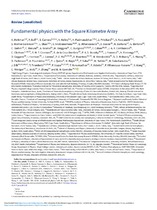| dc.identifier.citation | Weltman, A., Bull, P., Camera, S., Kelley, K., Padmanabhan, H., Pritchard, J., . . . Gaensler, B. (2020). Fundamental physics with the Square Kilometre Array. Publications of the Astronomical Society of Australia, 37, E002. doi:10.1017/pasa.2019.42 | en_US |
| dc.description.abstract | The Square Kilometre Array (SKA) is a planned large radio interferometer designed to operate over a wide range of frequencies, and with
an order of magnitude greater sensitivity and survey speed than any current radio telescope. The SKA will address many important topics
in astronomy, ranging from planet formation to distant galaxies. However, in this work, we consider the perspective of the SKA as a facility
for studying physics. We review four areas in which the SKA is expected to make major contributions to our understanding of fundamental
physics: cosmic dawn and reionisation; gravity and gravitational radiation; cosmology and dark energy; and dark matter and astroparticle
physics. These discussions demonstrate that the SKA will be a spectacular physics machine, which will provide many new breakthroughs
and novel insights on matter, energy, and spacetime. | en_US |

